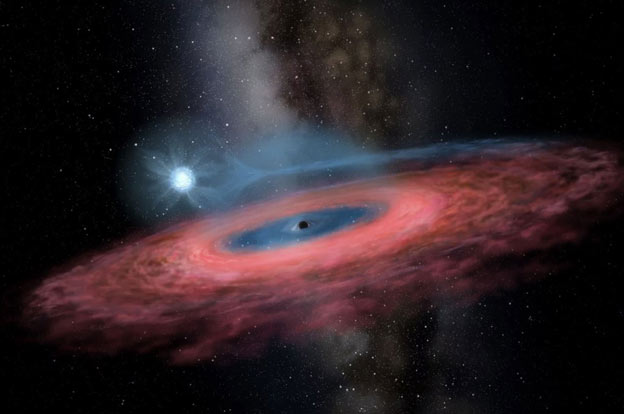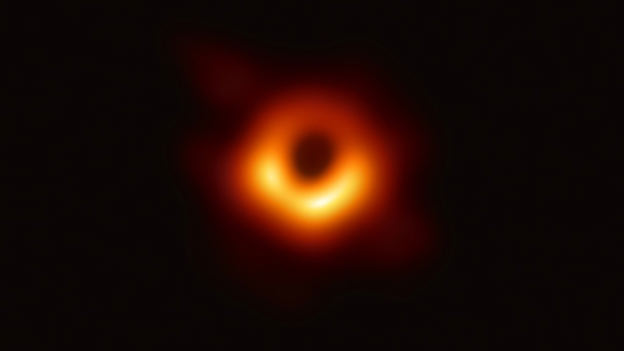The discovery of a giant black hole, 70 times the mass of the Sun in the Milky Way, challenges every theory
Scientists at the China National Astronomical Observatory have discovered a black hole with the mass 70 times more massive than the Sun in the Milky Way. This black hole was named LB-1, its existence shocked researchers by contradictory previous cosmological theories.
Researcher Liu Jifeng said he and his colleagues spent three years verifying with astronomers around the world before publishing their findings.

According to current astronomical theory, stars in space are made up of gas and heavy metals. The thermonuclear reaction that takes place inside their cores will cause light particles to combine to form heavier particles and release enormous energy.
But according to Einstein's famous formula E = mc², when matter converts into energy, the mass of a star decreases. Over billions of years, the star's energy will gradually fade, at some point collapsing under its own mass and becoming a black hole.
In theory, a giant black hole like LB-1 cannot exist in the Milky Way. The existence of LB-1 indicates a gap in the theory of the evolution of stars and the formation of black holes. This certainly makes astronomers rethink.

Expert Liu Jifeng said that LB-1 is twice as big as what he and his colleagues calculated. Explaining its formation will be a major challenge for astronomers.
The LB-1 black hole was discovered by the world's largest galactic scanning telescope system (including 4,000 small glasses), located in Hebei province. Each glass in this telescope system can focus on a specific target in the sky.
- Interesting facts about Saturn
- NASA's space telescope finds 3 new exoplanets with rare features
You should read it
- Discover the most bizarre black holes in the mysterious space universe
- Discover the terrible war between two giant black holes in the universe
- Find out how to weigh black holes based on galaxy spiral arms
- Our galaxy contains countless invisible black holes?
- A new discovery about the strange interaction between cosmic black holes and light
- Detecting monstrous black holes, 20 billion times larger than the sun and growing 'fast'
- black hole, white hole, deep hole
- Successfully creating cosmic black holes, demonstrating Hawking radiation exists
May be interested
- black hole, white hole, deep hole
 a black hole is a concept that is no longer new to most astronomers and physicists. in this article i will try to write in a short and understandable way possible about the concepts: black holes, white holes and deep holes.
a black hole is a concept that is no longer new to most astronomers and physicists. in this article i will try to write in a short and understandable way possible about the concepts: black holes, white holes and deep holes. - Hubble begins its hunt for hard-to-identify medium-sized black holes
 throughout the history of astronomical research, anthropologists have found numerous 'small muscle' black holes, with masses 100 times less than that of the sun.
throughout the history of astronomical research, anthropologists have found numerous 'small muscle' black holes, with masses 100 times less than that of the sun. - The first 'wandering black hole' was discovered, 7 times as massive as the sun, and it took scientists 6 years to observe it
 a black hole, or black hole, is a region of space-time where the gravitational field is so strong that nothing, particle matter or even electromagnetic radiation like light can escape it.
a black hole, or black hole, is a region of space-time where the gravitational field is so strong that nothing, particle matter or even electromagnetic radiation like light can escape it. - Detected the largest cosmic explosion in history, creating a light source 2 trillion times that of the Sun
 the explosion may have originated from the rare event where a giant gas cloud was swallowed up by a supermassive black hole.
the explosion may have originated from the rare event where a giant gas cloud was swallowed up by a supermassive black hole. - Black force - a new force in the universe, becomes even more strange
 this finding could affect how we simulate the formation of stars and planets, and even help us discover a theoretical form of radiation that explains the black hole's death (flight black hole).
this finding could affect how we simulate the formation of stars and planets, and even help us discover a theoretical form of radiation that explains the black hole's death (flight black hole). - This is a photograph of the first black hole of mankind, located in a galaxy 55 million light-years from Earth
 the first image of the black hole was announced by international scientists in the event horizon telescope (eht) program at the press conference held at 20:00 last night, april 10, 2019 (by hour vietnam).
the first image of the black hole was announced by international scientists in the event horizon telescope (eht) program at the press conference held at 20:00 last night, april 10, 2019 (by hour vietnam). - The streams of plasma sprayed from black holes can kill anything
 the plasma flow from the black hole produces a large amount of radiation, especially high-energy x-rays and gamma rays, which can destroy anything on their path.
the plasma flow from the black hole produces a large amount of radiation, especially high-energy x-rays and gamma rays, which can destroy anything on their path. - Astrophysics professor teaches how to jump into a black hole so it's 'safe' and possible events
 what if we decide to take the next step: visit, or even go into, a black hole? if you're determined to jump straight into the center of a black hole, you won't regret it.
what if we decide to take the next step: visit, or even go into, a black hole? if you're determined to jump straight into the center of a black hole, you won't regret it. - The largest-ever explosion in the universe created a giant hot-air sphere that could hold 15 Milky Way galaxies
 on february 27, 2020, astronomers at the center released the announcement of the most powerful explosion recorded in the history of the universe since the big bang. the explosion comes from a supermassive black hole at the center of a galaxy in the ophiuchus cluster, 390 million light-years from earth.
on february 27, 2020, astronomers at the center released the announcement of the most powerful explosion recorded in the history of the universe since the big bang. the explosion comes from a supermassive black hole at the center of a galaxy in the ophiuchus cluster, 390 million light-years from earth. - The moment a wandering black hole 'swallows' a star
 black holes are the hungry monsters of space: super-dense objects that suck in anything that gets too close and tear it apart.
black holes are the hungry monsters of space: super-dense objects that suck in anything that gets too close and tear it apart.










 The 10 greatest machines in human history
The 10 greatest machines in human history There is evidence that confirms the existence of a fifth force, which can reverse the physics we still know
There is evidence that confirms the existence of a fifth force, which can reverse the physics we still know Super rare scene: Blue whales ... 'walk heavy' in the middle of the ocean
Super rare scene: Blue whales ... 'walk heavy' in the middle of the ocean Every beer bottle cap has 21 aliases, why?
Every beer bottle cap has 21 aliases, why? Rossmax nasopharyngeal machine good? How to use it safely?
Rossmax nasopharyngeal machine good? How to use it safely? Why do traffic lights have 3 colors of red - yellow - blue and toilet paper must be white?
Why do traffic lights have 3 colors of red - yellow - blue and toilet paper must be white?